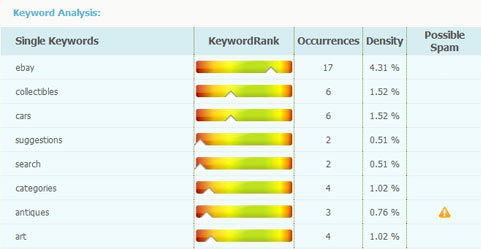Improve your website traffic by analyzing the SEO of your competitors – Part 2
Andrew is the Founder and Managing Director at e-mphasis, an internet marketing agency specialising in providing Search Marketing and Social Media Marketing. E-mphasis is a finalist in the National Business Awards 2010 in the UK for Excellence in Marketing. Follow Andrew on Twitter

In the previous article we have discussed how to analyze the competition on Search Engine Results and how to select the search terms that will allow you to rank higher. On this second part we will examine in detail how to analyze the SEO campaigns of your competitors and how to achieve high rankings on those terms. Note that the 2 key SEO factors that will improve your search result position can be found through your competitor’s web pages.
Turning the Tables Using SEO
Ironically the content and links that enable your competitors to beat your current position are also the tools you can use against them. Every page listed on Google is there because it is either focused on content or considered important through page rank, authority and backlinks.
1. USING THEIR WORDS AGAINST THEM:
Investigate how well focused the competitor pages are on the phrase in question. Use the Web SEO analysis Tool to check the word frequency, the KeywordRank and identify use of the phrase in Meta tags. If this indicates only limited use of the phrase then given they are highly positioned in search results, then it may be down to page rank. This suggests you may be able to overtake them through more focused content, but beware a change in their content could easily leapfrog you again in future. To identify where you could improve on their SEO, look at the following aspects:
- URL phrase content
- Meta tags
- Word/Phrase frequency
- HTML Headings
Making sure that your content is better focused for key phrases can sometimes be enough to overcome higher PageRank/Authority competitor. Check your competitor pages for obvious SEO techniques like standardised Meta tag lengths, image and link title tags and text frequency. These will normally indicate that a page has had some investment in search optimisation and you may be able to short cut the above list by using their approach and then spotting the gaps in their SEO ability e.g. No headings or poor phrase frequency.
2. LEVERAGE THEIR LINKS:
By investigating the high page rank inbound links to your competitor’s pages you can find new links for your own pages. Use the Backlink Analysis tool to analyze their backlink campaign and then combine the results with the PageRank Check tool to find the quality links of their pages.
The key here is that in theory you can compound the benefit of all the links coming in to the top 3 results, many of which may not be in common, in order to boost your rankings. Using the search phrase in the link text (anchor text) can also improve the value of these backlinks. Once you identify the most important sources of the quality links you can contact the webmasters or editors, present your site and request a link. This works very often especially in blogs that try to gather the best X services, products, sites etc. If this doesn’t work, try encouraging them through a link swap or perhaps engage with them on social media to identify how you might collaborate. You can also consider using affiliate programs or offer philanthropic sponsorship.
Remember to Tell Everyone?
Having amended your content and built new links to improve both content and page rank, the only remaining task is to let the search engines know by submitting your site and sitemap to the major search engines. Don’t forget to keep a regular check on your site, the phrases you targeted and both existing and any new competition.
Don’t Be Fooled By Google
Searching Google to see where you appear? Your web page may not actually be in the position that you are shown. By default Google customises the order of search results based on your search history. Make sure that you disable browser customisation based on search history or you’ll skew your own results.
A good way to compare your rankings with the ones of your competitors is to use the Keyword Battle tool. This tool allows you to submit a list of keywords along with the websites that you would like to oppose and search them in the Search Engine of your choice. The report will provide you all the information that you need about the competition and the rankings of those sites.
Results in an Instant
Following the recent announcement by Google regarding their new Instant Search capability, SEO takes on a new slant. Organisations need to take account of phrases that appear as the letters of their key phrases are being typed and take advantage of any opportunities to focus on related predicted search results that would highlight their pages to the searcher more rapidly. Using this competitive research method of targeting the top positions will become more relevant as this technology will mean that first page results get greater visibility.

 7 Comments
7 Comments




